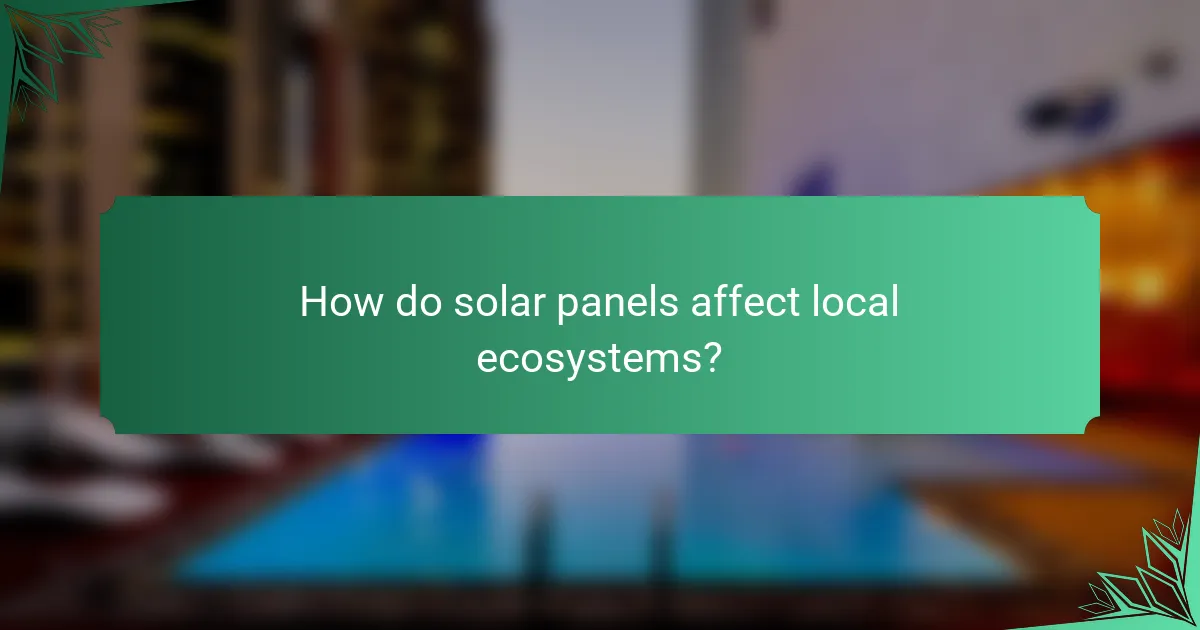
What are the Environmental Benefits of Solar Panels?
Solar panels provide significant environmental benefits. They reduce greenhouse gas emissions by generating clean energy. According to the U.S. Environmental Protection Agency, solar energy can prevent about 4,000 tons of carbon dioxide emissions per megawatt installed annually. This contributes to a decrease in air pollution, improving overall air quality. Solar panels also conserve water, as they require less water for energy production compared to fossil fuels. Additionally, they promote sustainable energy practices, encouraging a shift towards renewable resources. By reducing reliance on fossil fuels, solar panels help mitigate climate change impacts.
How do solar panels contribute to reducing carbon emissions?
Solar panels contribute to reducing carbon emissions by generating electricity without burning fossil fuels. They harness sunlight to produce clean energy. This process eliminates the carbon dioxide emissions associated with traditional energy sources. According to the U.S. Department of Energy, solar power can reduce greenhouse gas emissions by up to 90% compared to coal. Each megawatt-hour of solar energy produced can prevent approximately 1.5 tons of carbon dioxide from entering the atmosphere. As more households and businesses adopt solar technology, the overall reliance on fossil fuels decreases. This shift leads to a significant reduction in carbon emissions nationwide.
What is the impact of solar energy on greenhouse gas emissions?
Solar energy significantly reduces greenhouse gas emissions. By replacing fossil fuels, solar power decreases carbon dioxide output. According to the U.S. Environmental Protection Agency, solar energy can prevent over 4 billion metric tons of CO2 emissions annually. Solar panels generate electricity without burning fuel. This leads to cleaner air and lower greenhouse gas concentrations. Additionally, the lifecycle emissions of solar panels are minimal compared to traditional energy sources. The transition to solar energy is crucial for mitigating climate change.
How do solar panels compare to fossil fuels in terms of emissions?
Solar panels produce significantly lower emissions compared to fossil fuels. The lifecycle greenhouse gas emissions from solar energy are about 20 to 50 grams of CO2 equivalent per kilowatt-hour. In contrast, fossil fuel sources release approximately 900 grams of CO2 equivalent per kilowatt-hour. This stark difference highlights solar panels’ efficiency in reducing carbon footprints. Fossil fuel combustion contributes to air pollution and climate change. Solar energy, being renewable, has minimal environmental impact during operation. Studies show that transitioning to solar can reduce overall emissions substantially.
What role do solar panels play in energy consumption reduction?
Solar panels significantly reduce energy consumption by generating renewable electricity. They convert sunlight directly into power, minimizing reliance on fossil fuels. This transition leads to lower greenhouse gas emissions. According to the U.S. Department of Energy, solar energy can reduce electricity bills by 50% or more. Additionally, solar panels can provide energy during peak demand times, reducing the need for energy from non-renewable sources. Studies show that widespread adoption of solar technology can lead to substantial energy savings on a national scale. Overall, solar panels play a crucial role in energy conservation and environmental sustainability.
How much energy can solar panels save in residential settings?
Solar panels can save homeowners approximately 50% to 90% on their electricity bills. The savings depend on factors such as the size of the solar system, energy consumption, and local solar incentives. On average, a typical residential solar installation can produce around 10,000 kWh per year. This output can cover most of a household’s energy needs. According to the U.S. Department of Energy, solar energy can significantly reduce reliance on grid electricity. This reduction leads to lower energy costs and decreased carbon emissions. The effectiveness of solar panels in saving energy is well-documented and widely recognized.
What are the energy efficiency benefits of using solar panels?
Solar panels significantly enhance energy efficiency by converting sunlight into usable electricity. This process reduces reliance on fossil fuels, which are less efficient and produce greenhouse gases. Solar panels can achieve an efficiency rate of 15% to 22% in converting solar energy. This efficiency translates into lower energy costs for consumers. According to the U.S. Department of Energy, solar energy systems can reduce electric bills by 50% to 90%. Additionally, solar panels produce energy during peak usage times, further optimizing energy consumption. By generating electricity on-site, they minimize energy loss that occurs during transmission. Overall, the energy efficiency benefits of solar panels contribute to a more sustainable energy future.

How do solar panels affect local ecosystems?
Solar panels can impact local ecosystems in various ways. They can alter land use patterns by converting natural habitats into solar farms. This transformation can lead to habitat loss for local wildlife. Additionally, solar panels can affect soil quality and water drainage in the area.
Research indicates that solar farms can create microhabitats, which may benefit certain species. For example, pollinator-friendly plantings around solar installations can support local bee populations. However, the overall effect on biodiversity can vary depending on the location and design of the solar project.
Studies have shown that properly managed solar farms can coexist with agricultural practices. This dual-use approach can enhance land productivity while minimizing ecological disruption. Overall, the ecological impact of solar panels is complex and context-dependent.
What are the potential ecological impacts of solar panel installations?
Solar panel installations can have several potential ecological impacts. One significant impact is land use change. Large-scale solar farms may require clearing vegetation and disrupting local ecosystems. This can lead to habitat loss for wildlife. Additionally, the production of solar panels involves mining for raw materials. This mining process can result in soil degradation and water pollution. Another concern is the end-of-life disposal of solar panels. Improper disposal can lead to toxic materials leaching into the environment. However, advancements in recycling technologies are being developed to mitigate this issue. Overall, while solar panels offer environmental benefits, careful planning is essential to minimize their ecological impacts.
How can solar farms coexist with wildlife habitats?
Solar farms can coexist with wildlife habitats through careful planning and management. Implementing strategies like site selection, which avoids critical habitats, is essential. Integrating native vegetation can provide food and shelter for local wildlife. Additionally, solar farms can create new habitats by allowing grasslands and shrubs to thrive beneath and around panels. Research indicates that solar installations can enhance biodiversity when designed thoughtfully. Studies show that solar farms can support pollinators and other beneficial species, promoting ecosystem health. By using dual-use systems, solar farms can be combined with agriculture, further benefiting wildlife.
What measures are taken to minimize land use impact?
Solar panels are installed with measures to minimize land use impact. One approach is the use of rooftop installations. This method utilizes existing structures, reducing the need for additional land. Another measure is the implementation of solar farms on degraded or brownfield sites. These areas are often unsuitable for agriculture or development, thus preserving untouched land. Additionally, agrivoltaics combines agriculture and solar energy production on the same land. This practice allows for dual land use, maximizing productivity without expanding the footprint. Finally, policies and regulations often guide solar development to avoid ecologically sensitive areas. These strategies collectively help to mitigate the land use impact of solar energy systems.
What are the long-term environmental advantages of solar energy?
Solar energy offers significant long-term environmental advantages. It reduces greenhouse gas emissions, which contribute to climate change. According to the U.S. Environmental Protection Agency, solar power can prevent over 90 million metric tons of carbon dioxide annually. Solar energy also decreases reliance on fossil fuels, promoting cleaner air. This shift leads to improved public health outcomes by reducing air pollution. Additionally, solar installations can conserve water, as they require less water compared to conventional energy sources. The National Renewable Energy Laboratory states that solar energy uses 90% less water than fossil fuel energy production. Overall, solar energy contributes to a sustainable future by minimizing environmental degradation.
How does solar energy contribute to sustainable development?
Solar energy contributes to sustainable development by providing a clean and renewable energy source. It reduces reliance on fossil fuels, which are major contributors to greenhouse gas emissions. According to the International Energy Agency, solar power can significantly lower carbon footprints. In 2020, solar energy helped avoid approximately 1.5 billion tons of CO2 emissions globally. Additionally, solar energy promotes energy independence and security. It can create local jobs in manufacturing and installation. This supports economic growth while preserving the environment. Overall, solar energy plays a vital role in achieving sustainable development goals.
What are the implications of solar energy for future generations?
Solar energy has significant implications for future generations. It offers a sustainable energy source that reduces reliance on fossil fuels. This shift can lead to lower greenhouse gas emissions. According to the International Energy Agency, solar power could provide up to 16% of global electricity by 2050. This transition supports climate change mitigation efforts. Additionally, solar energy promotes energy independence for countries. It can create new job opportunities in renewable energy sectors. The long-term cost of solar technology is decreasing, making it more accessible. Overall, solar energy enhances environmental sustainability for future generations.

What challenges exist in the adoption of solar panels?
High initial costs present a significant challenge in the adoption of solar panels. The average installation cost can range from $15,000 to $25,000 for residential systems. This upfront investment can deter potential users, despite long-term savings on energy bills. Additionally, solar panel efficiency can be affected by geographic location. Areas with less sunlight may not yield sufficient energy to justify the expense. Furthermore, there are regulatory and permitting hurdles. Local regulations can vary widely, complicating the installation process. Lastly, there is a lack of consumer awareness regarding solar technology benefits. Many potential users are not fully informed about available incentives and financing options. These challenges collectively hinder the widespread adoption of solar panels.
What are the common misconceptions about solar energy’s environmental impact?
Common misconceptions about solar energy’s environmental impact include the belief that solar panels are harmful to the environment. Many people think that the production of solar panels generates excessive pollution. In reality, advancements in technology have significantly reduced emissions associated with solar panel manufacturing. Another misconception is that solar energy cannot contribute to reducing carbon footprints. Studies show that solar energy can reduce greenhouse gas emissions by up to 90% compared to fossil fuels. Additionally, some believe that solar panels require more energy to produce than they generate. However, research indicates that solar panels typically pay back their energy input within 1 to 4 years, depending on the location and technology used. Lastly, there is a notion that solar energy is not sustainable due to land use concerns. In fact, solar installations can coexist with agriculture and even enhance land use efficiency.
How can misinformation affect public perception of solar energy?
Misinformation can significantly distort public perception of solar energy. It can lead to skepticism about the technology’s effectiveness and reliability. For instance, false claims about high costs can deter potential adopters. Studies show that misconceptions about solar energy’s efficiency contribute to negative attitudes. The National Renewable Energy Laboratory reports that misunderstandings about solar panel lifespan reduce consumer interest. Furthermore, misinformation can amplify fears regarding environmental impacts, overshadowing the actual benefits. Accurate information is crucial for fostering acceptance and encouraging investment in solar technologies.
What are the challenges in recycling solar panels?
The challenges in recycling solar panels include technical, economic, and regulatory issues. Technical challenges arise from the complex materials used in solar panels, such as silicon, metals, and glass. These materials require specialized processes for effective separation and recovery. Economic challenges stem from the high costs associated with recycling processes compared to the value of recovered materials. This often leads to a lack of investment in recycling facilities. Regulatory challenges involve inconsistent policies across different regions. This inconsistency can hinder the development of standardized recycling practices. According to a report by the International Renewable Energy Agency, only about 10% of solar panels are currently recycled. This highlights the need for improved recycling solutions and infrastructure.
What best practices can enhance the environmental benefits of solar panels?
To enhance the environmental benefits of solar panels, proper installation and maintenance are crucial. Ensuring optimal orientation and tilt maximizes energy capture. Regular cleaning of solar panels prevents dirt accumulation, which can reduce efficiency. Utilizing high-efficiency solar panels increases energy output per square meter. Implementing energy storage systems allows for better use of generated power. Additionally, integrating solar panels with energy-efficient appliances reduces overall energy consumption. Following local regulations and guidelines ensures safe and effective installation. Research indicates that well-maintained solar systems can reduce carbon emissions significantly, contributing to a greener environment.
How can homeowners maximize the efficiency of their solar systems?
Homeowners can maximize the efficiency of their solar systems by ensuring optimal placement and maintenance. Proper positioning maximizes sunlight exposure throughout the day. Regular cleaning of solar panels removes dirt and debris that can block sunlight. Utilizing energy storage systems allows homeowners to use solar energy during non-sunny hours. Monitoring energy consumption helps identify patterns and optimize usage. Upgrading to energy-efficient appliances reduces overall energy demand. Additionally, homeowners should consider professional assessments to optimize system performance. Studies show that well-maintained solar systems can operate at up to 25% more efficiency.
What maintenance tips are crucial for sustaining solar panel performance?
Regular cleaning is crucial for sustaining solar panel performance. Dust, debris, and bird droppings can block sunlight and reduce efficiency. Clean panels at least twice a year to maintain optimal energy production. Inspect the panels for any signs of damage or wear. Check for loose connections and ensure the wiring is intact. Monitor the inverter’s performance regularly. A functioning inverter is essential for converting sunlight into usable energy. Trim any nearby vegetation that may cast shadows on the panels. Ensure proper drainage to prevent water accumulation. Following these tips can enhance solar panel efficiency and longevity.
The main entity of the article is solar panels, which are explored for their environmental benefits, particularly in reducing carbon footprints and energy consumption. The article details how solar panels generate clean energy, significantly decreasing greenhouse gas emissions, conserving water, and promoting sustainable practices. It discusses the impact of solar energy on local ecosystems, challenges in adoption, common misconceptions, and best practices for maximizing efficiency. Additionally, the article highlights the long-term advantages of solar energy for future generations and the necessity of proper management to mitigate ecological impacts.